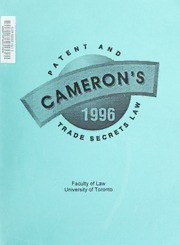
Cameron's patent and trade secrets law PDF
Preview Cameron's patent and trade secrets law
6 7 0 4 8 2 3 3 0 1 6 7 1 3 Faculty of Law University of Toronto •Q. % 7 Aw >■■/ - S ca / CSSA LASKM LAW LIBRARY JAN 1 0 1996 FACULTY OF LAW UNIVERSITY OF TOAOHTO BORA LASKIN LAW LIBRARY UNIVERSITY OF TORONTO Faculty of Law University of Toronto Digitized by the Internet Archive in 2018 with funding from University of Toronto https://archive.org/details/cameronspatenttrOOcame Table of Contents 1996 CHAPTER 1: Introduction INTRODUCTION.1-1 The Monopoly.1-1 The Structure of a Patent.1-1 The Title Page.1-4 The Abstract.1-5 The Disclosure.1-6 The Claims.1-8 The fence(s).1-9 Types of Claims.1-13 Jepson claim.1-13 Markush claims.1-16 Example of a Skeleton of a Patent.1-17 History.1-19 CHAPTER 2 - WHAT IS AN INVENTION? THE LEGISLATIVE BASIS.2-1 THE PREREQUISITES.2-1 Novelty.2-7 Utility.2-12 Non-Obviousness or Inventive Ingenuity.2-18 the inventive process.2-19 the inventive creator.2-20 quantum.2-20 COMBINATIONS NOT AGGREGATIONS.2-23 SUBJECT MATTER.2-24 Approved Categories.2-24 "art".2-25 "process".2-27 "machine".2-28 "manner of manufacture".2-29 "composition of matter".2-29 11 "improvements".2-31 Non-statutory subject matter.2-31 Prohibited Subject Matter.2-31 THE NEW TECHNOLOGIES.2-32 Computer Program-Related Inventions.2-32 Biotechnology.2-50 CHAPTER 3: THE APPLICATION PROCESS The Three Requirements.3-1 The Inventor.3-4 The Application.3-7 Money.3-29 Patent Cooperation Treaty.3-31 CHAPTER 4 CLAIM CONSTRUCTION The Purpose of the Claims.4-1 The First Duty.4-4 The Addressee.4-6 Date to Construe.4-13 Attitude of the Reader.4-17 Use of the Disclosure.4-20 Use of other documents.4-39 File Wrapper Estoppel. 4-41 Use of Expert Witnesses 4-45 Ill CHAPTER 5 INFRINGEMENT A The Legislative Basis.5-1 B Introduction.5-2 B. 1 purpose or intent is irrelevant in Canada.5-2 B.2 geographic limitation.5-4 B. 3 Importation.5-9 B 4 Parties.5-12 C. Onus.5-14 D Mixed Question of Law and Fact.5-15 C. l Evidence on the ultimate issue.5-15 E. Comparing the Claims to the alleged infringement.5-16 E. 1 Literal or textual infringement.5-17 E.2 Infringement of the Pith and Substance.5-19 E.2.1 the essential integers.5-26 E.2.2 the non-essential integer.5-26 E.2.2.1 the missing integer.5-27 E.2.2.2 replaced with a variant/equivalent.5-29 F. Infringing Improvements.5-39 G Inducement and Procurement.5-41 H Statutory Defences.5-66 CHAPTER 6 Validity - Anticipation A. THE LEGISLATIVE BASIS.6-1 B ONUS.6-1 C PRIOR KNOWLEDGE AND USE: ANTICIPATION.6-6 C. 1 The Legislative Basis.6-6 C.2. What is the invention?.6-11 C. 3 Date of Invention.6-11 C.4 Prior Knowledge or use before invention date.6-13 C.5. Prior Printed Publication.6-13 C.5.1 Reeves Brothers test.6-15 C.6 Prior Public Use or Sale.6-25 IV C .7 Weight of the Evidence.6-27 C.7.1 Paper patents willed be viewed very Strictly.6-27 C. 8 The Infringement Test.6-28 D COVETOUS CLAIMING.6-32 D. 1 broader than the invention made.6-32 D. 2 broader than the invention described.6-39 CHAPTER 7 Validity - Obviousness E OBVIOUSNESS.7-1 E. l Introduction.7-1 E.2The Cripps Question.7-4 E.2.1 The notional skilled worker.7-6 E.2.2 having common general knowledge and the prior art.7-8 E.2.2.1 paper patents viewed with skepticism.7-15 E.2.3 at the date of invention.7-18 E.2.4 led directly and without difficulty to the solution.7-21 E.3 Commercial Success.7-24 E.4The wrong tests.7-31 E.4.1 dissection.7-31 E.4.2 ex post facto - 20/20 hindsight.7-33 E. 5Evidence and expert witnesses.7-35 CHAPTER 8 Validity - Latent Defects F DEFECTS IN THE PATENT.8-1 F. 1 Inadaquate Disclosure.8-1 F.2 Ambiguous Claims.8-13 G. IMPEACHMENT PROCEEDINGS 8-23 V CHAPTER 9 Remedies A. RELIEF IN PATENT INFRINGEMENT ACTIONS.9-1 A. 1 Inspection.9-1 A.2 Election.9-2 A. 3 Mareva Injunctions and Security for Damages.9-2 B. RELIEF IN PATENT INFRINGEMENT ACTIONS - PART II.9-4 B. 1 The American Cyanamid Rule.9-4 C. RELIEF IN PATENT INFRINGEMENT ACTIONS - PART in.9-7 C. l Permanent Injunction.9-7 C.2 Delivery Up and Destruction.9-7 C.3 Profits.9-8 C.4 Damages.9-8 C.5 Limitation Period.9-9 C.6 Pre- and Post-Judgment Interest.9-9 CHAPTER 10 Assignment/Licence A. TRANSFERS AND ASSIGNMENTS.10-1 A. 1 General. 10-1 B LICENSING.10-2 B. l General.10-2 B.2 Types of License.10-2 B.2.1 Exclusive License.10-3 B.2.2 Non-exclusive License.10-3 B.2.3 Sole License.10-3 B.3 Compulsory License.10-4 B.4 Patent License Agreement.10-5 C. PATENT LICENSE AGREEMENT CHECKLIST.10-6 D. LICENSE AGREEMENT FOR A PATENTED PRODUCT.10-11 VI CHAPTER 11 Trade Secrets A. OWNERSHIP / CREATION OF CONFIDENTIAL INFORMATION.11-2 A. 1 Is confidential information property? A. 2 What is confidential? A3 Trade secrets no longer deserving protection. B. COMMUNICATION TO THE RECIPIENT.11-6 B. 1 Circumstances or a Relationship of Confidence a. Explicit Contract Confidential Disclosure Agreement b. Implicit Contract Employee's Implied Obligation Non-Contractual Obligations c. Fiduciary Duty d. Confidentiality Understood From the Circumstances C. MISUSE OF THE CONFIDENTIAL INFORMATION.11-22 C.l Unauthorized Use C.2 Onus D REMEDIES.11-23 D.l. Damages D.2 Accounting of Profits D.3 Punitive Damages D.4 Injunctive Relief D.5 Springboard D.6 Constructive Trust
